Lecture 37: cell metabolism
1/22
There's no tags or description
Looks like no tags are added yet.
Name | Mastery | Learn | Test | Matching | Spaced |
|---|
No study sessions yet.
23 Terms
what is metabolism?
the interconversion of biomolecules using chemical reactions
catalysed by enzymes
what are examples of catabolic reactions(degradative)?
they are all oxidative, reduce other things
production of:
chemical energy(ATP)and ion gradients
mechanical energy(muscle contraction)
reducing equivalents(NADH, NADPH)
biosynthetic precursors(simple molecules which make other stuff)
what are examples of anabolic reactions(biosynthetic)?
reductive
storage of energy
production of macromolecules and cellular structures (more complex molecules)
how is the gibbs free energy of the reaction described?
temp is fixed at 310.15 K and R is a constant 8.314
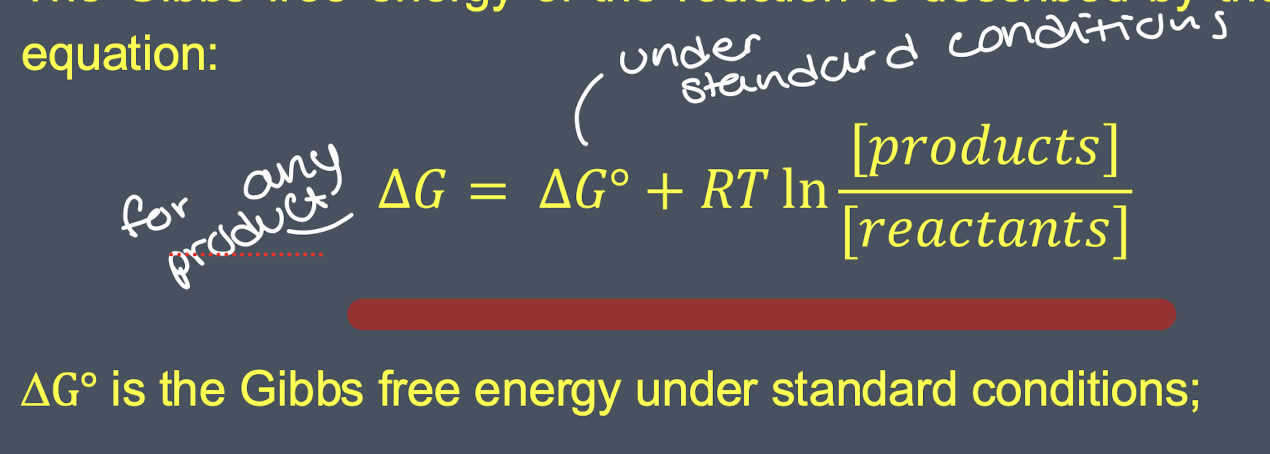
biological reactions are in a state of flux(chemicals are interconverted through a successive series of steps) - no clue
endothermic reactions require energy input. How does this happen
reactions are often driven by ATP or pyrophosphate hydrolysis
negatively charged Pi groups mean ATP is relatively easily hydrolysed so groups can separate from eachother
hydrolysis of ATP can change the equilibrium constant of a coupled reaction by 10^8 per hydrolysed molecule
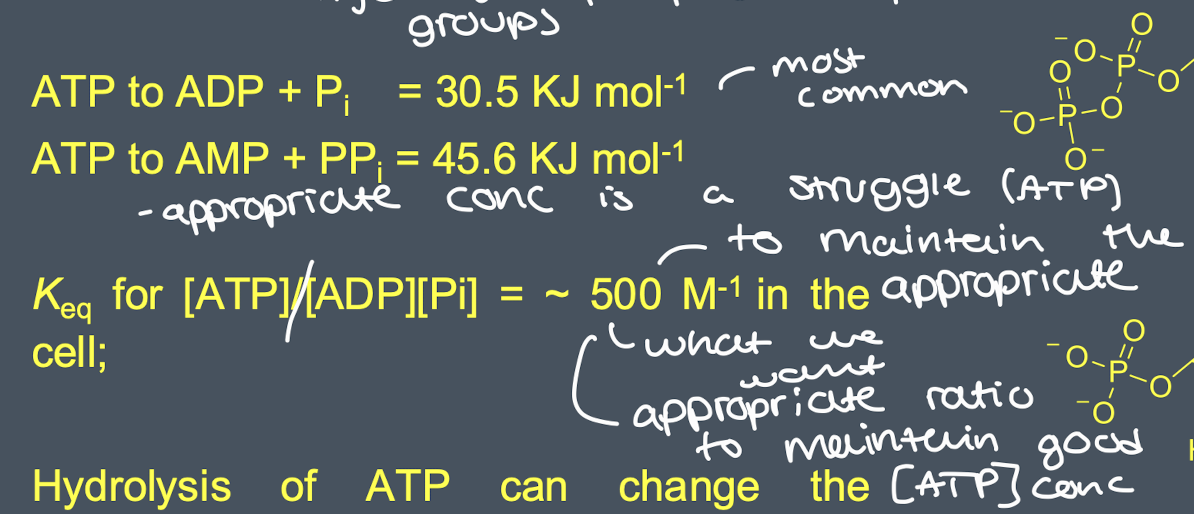
NAD+ to NAD
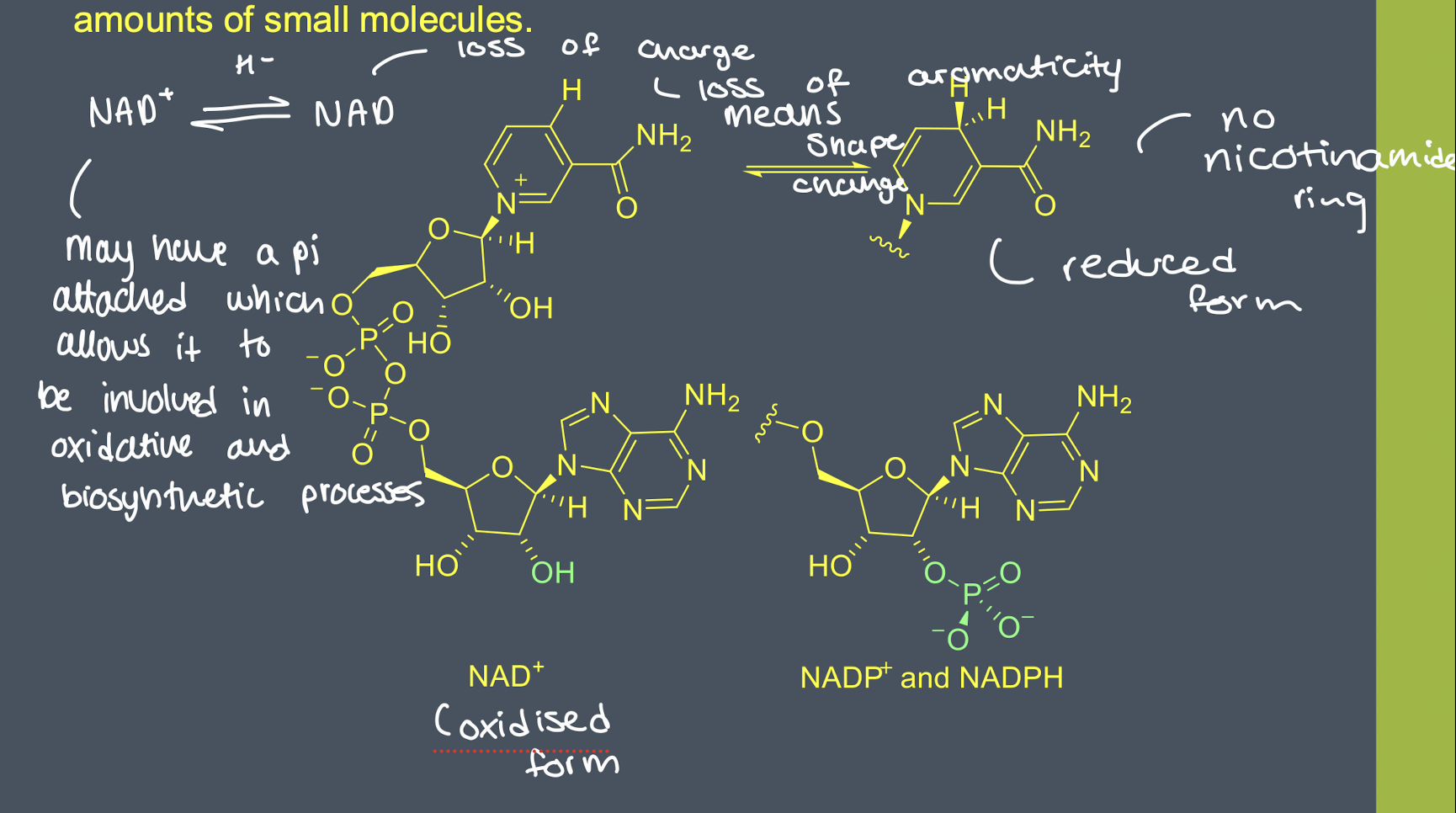
what is the first stage of glycolysis?(three steps)
glycolysis occurs in the cytosol
phase 1 activates glucose for metabolism and uses 2 ATP’s
double phosphorylation causes ring opening of sugar
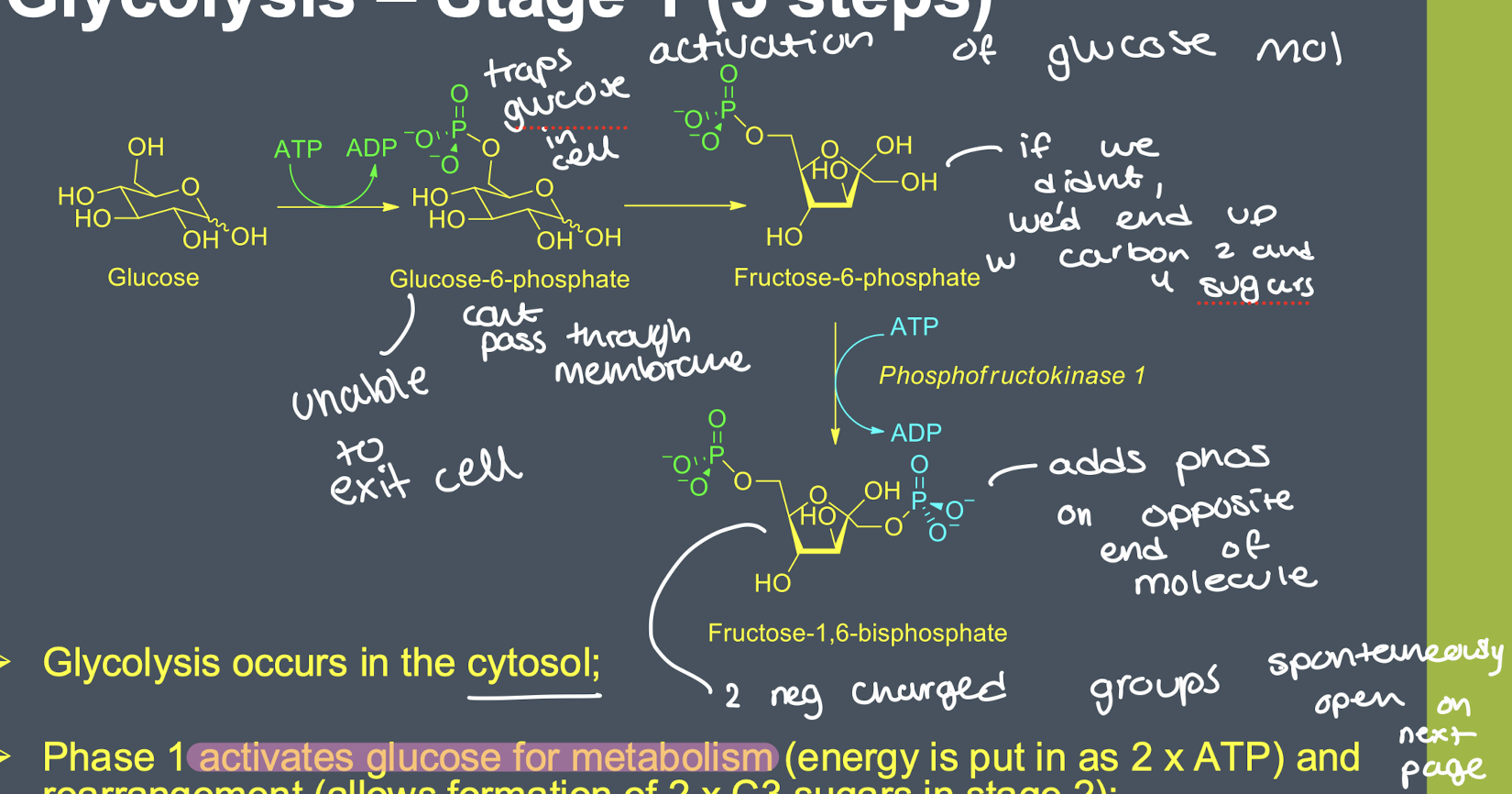
what is the second stage of glycolysis?(2 steps)
fructose-1,6-bisphosphate is converted into dihydroxyacetone phosphate and glyceraldehyde-3-phosphate
dihydroxyacetone phosphate is converted into glyceraldehyde-3-phosphate by triose phosphate isomerase
net products are 2x glyceraldehyde-3-phosphate
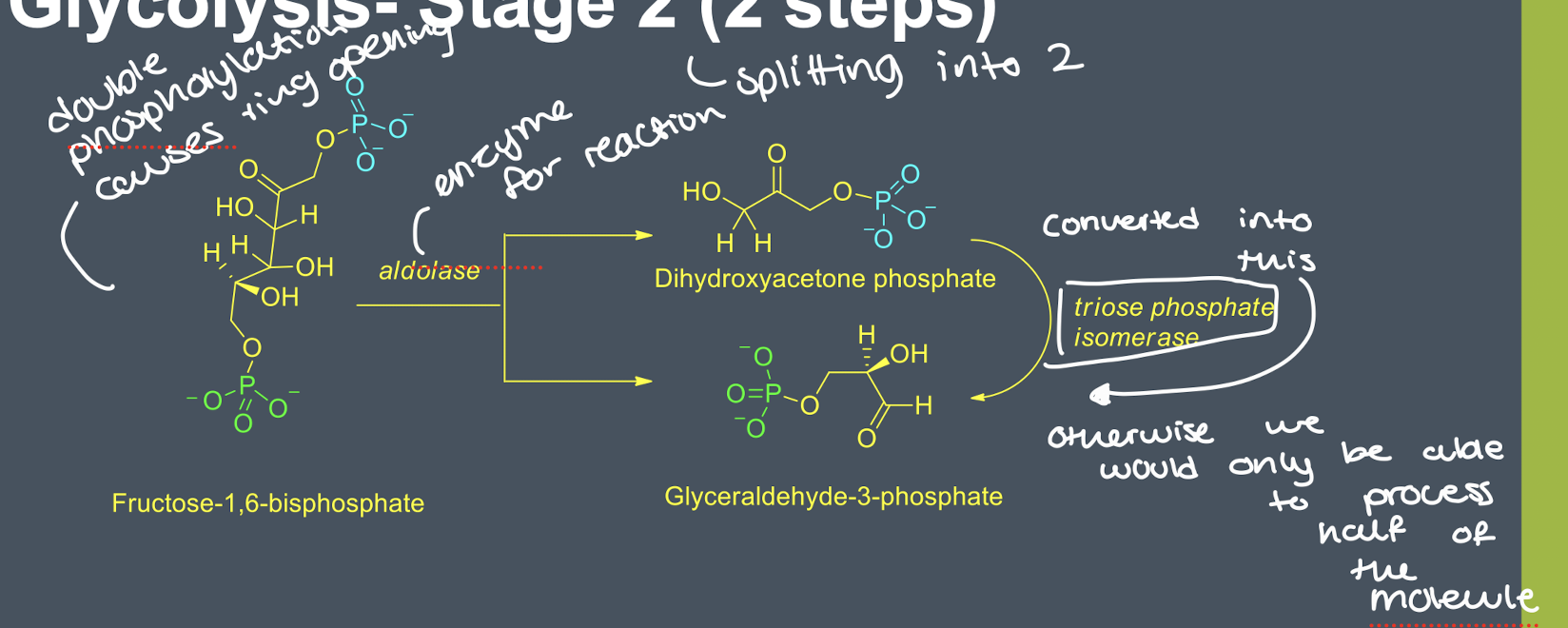
what is the third stage of glycolysis?(5 steps)
each step is repeated twice as 2 molecules of glyceraldehyde-3-phosphate are generated in step 2
energy producing stage as products are 2 NADH and 4 ATP
net gain of 2 ATP
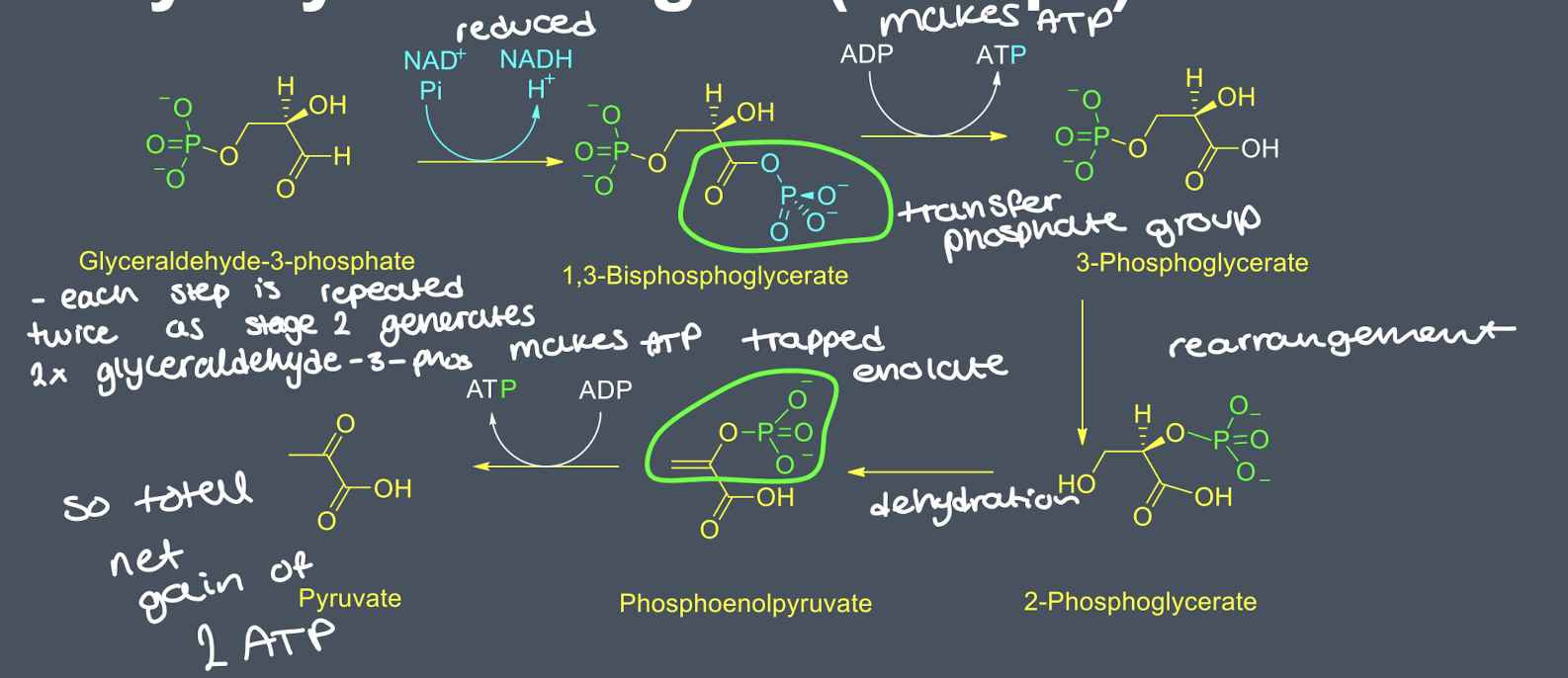
how is pyruvate used for anaerobic respiration?
occurs in the muscle during anaerobic exercise typically
in the absence of oxygen, pyruvate is reduced to R-lactate(D-lactate)
this oxidises NADH to NAD+ and allows glycolysis to continue
R-lactate can be reoxidised to pyruvate using NAD+
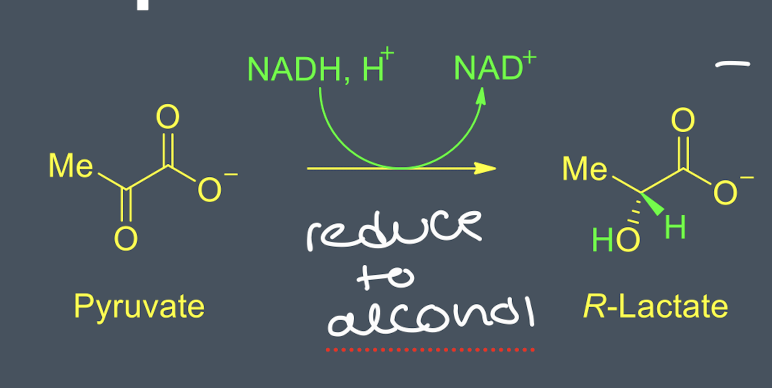
what is the cori cycle?
recycles R-lactate to glucose
lactate is transported from muscle to liver in blood
lactate dehydrogenase in liver converts R-lactate to pyruvate
pyruvate is converted to glucose by gluconeogenesis
process requires input of 6 ATP per glucose molecule a
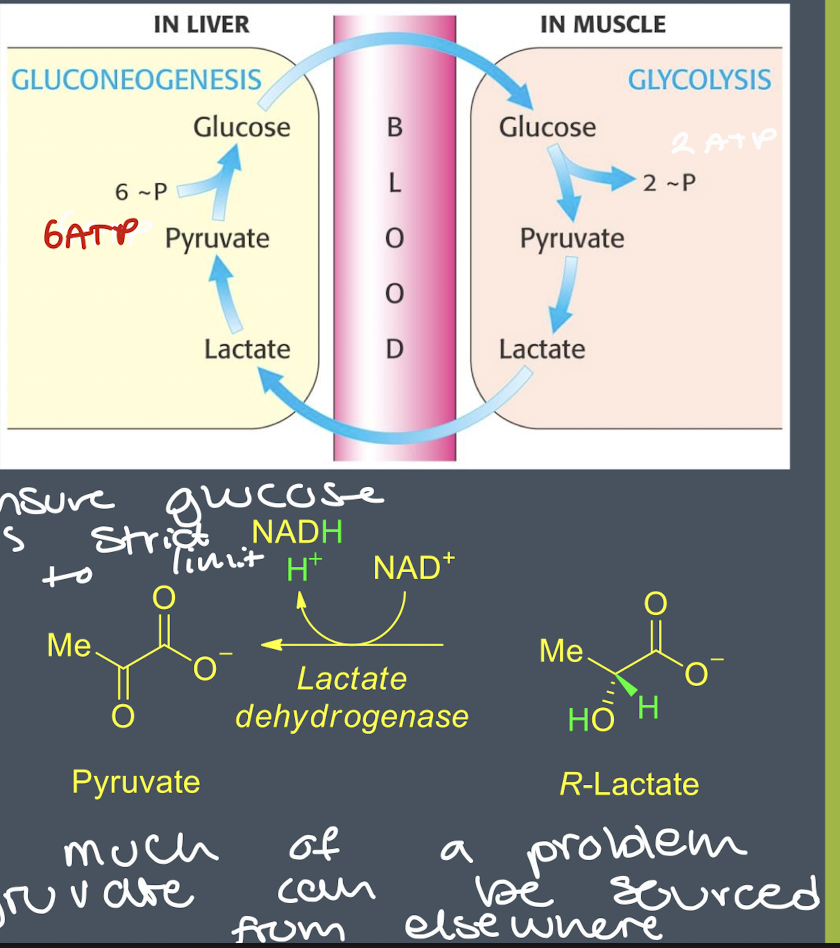
what is the process of gluconeogenesis?
primarily occurs in the liver cytosol
2 pyruvates needed for each glucose
ATP, CO2 and pyruvate make oxaloacetate in mitochondria. its exported to the cytosol and converted into phosphoenolpyruvate
2 ATP and one NADH needed
additional enzymes are needed which are only found in the liver
phosphatase allows export of glucose to other tissues
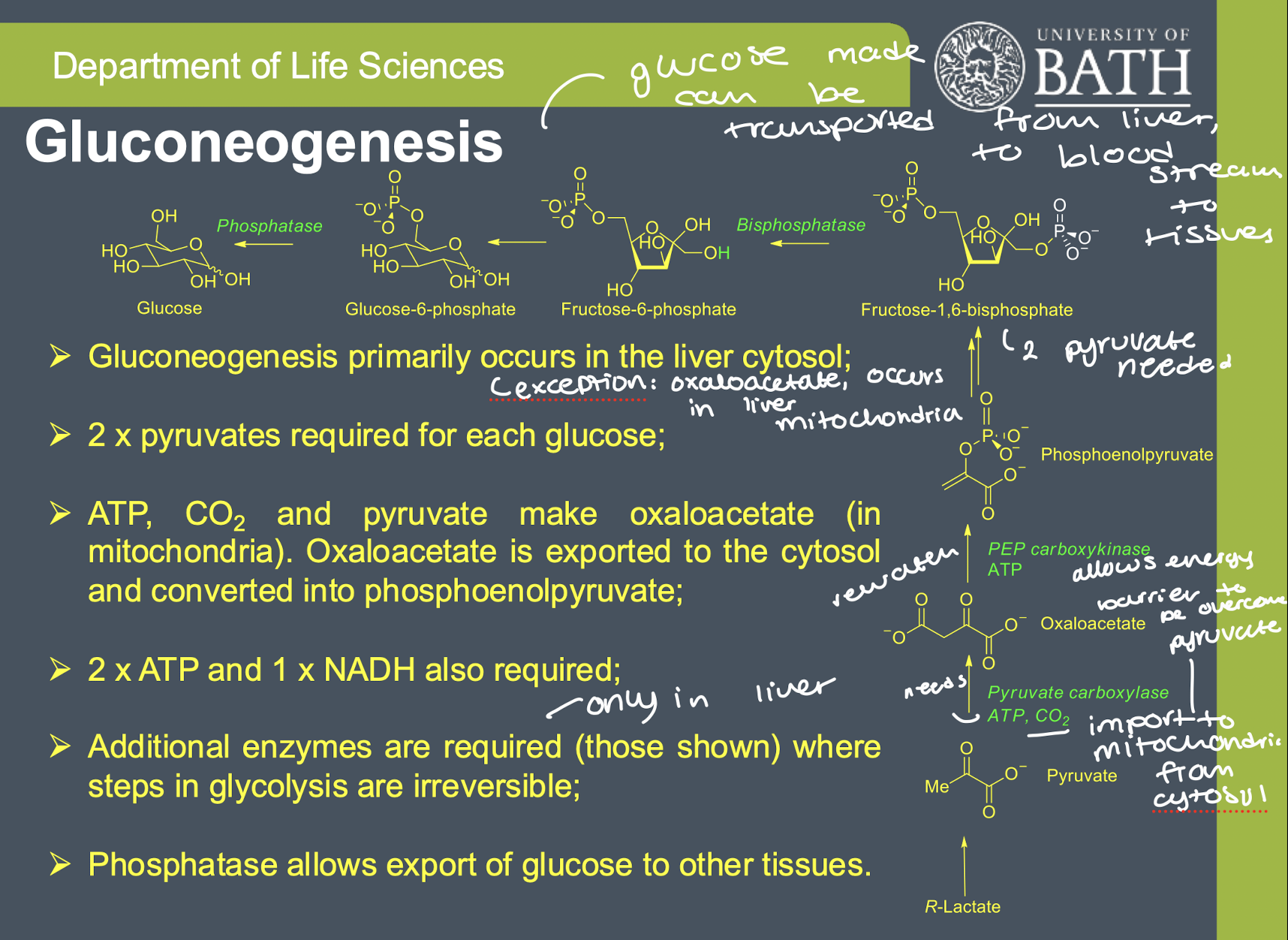

what is the structure of mitochondria?
mitochondria plays a key role in aerobic respiration
important for the degradation of glucose and fats
matrix contains the enzymes for the tricarboxylic acid cycle
membranes are needed for electron transport system
mitochondria also have a role in gluconeogenesis
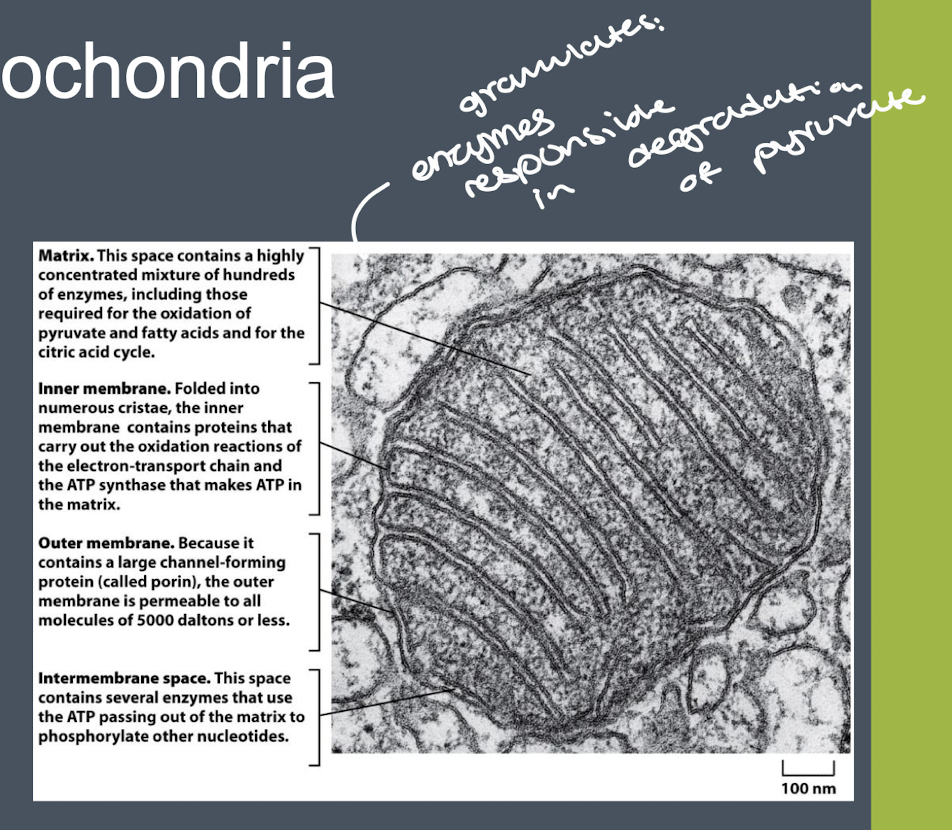
what is the pyruvate dehydrogenase complex?
it controls the enrty of pyruvate into the TCA cycle. it has 3 types of subunits
what are the 3 types of subunits and their features?
Pyruvate dehydrogenase(E1):
decarboxylates pyruvate, requires thiamine pyrophosphate(TPP)
goes from C3 to C2
Dihydrolipoyl transferase(E2):
makes CoA(requires lipoamide)
attaches CoA molecules to decarboxylated pyruvate molecule
Dihydrolipoyl dehydrogenase(E3)
converts reduced lipoamide to disulfide form(requires FAD)
back to start of the reaction to start again
mammals have 30 E1, 12 E2 and 12 E3
how is acetyl-CoA formed?
TPP anion adds to pyruvate and CO2 is released
Lipoamide disulfide is added to acetyl group and a redox reaction occurs
disulfide exchange occurs to form acetyl-CoA and reduced lipoamide
reduced lipoamide is oxidised to disulfide form using FAD
FADH2 is oxidised by NADH, which is fed into the electron transport system
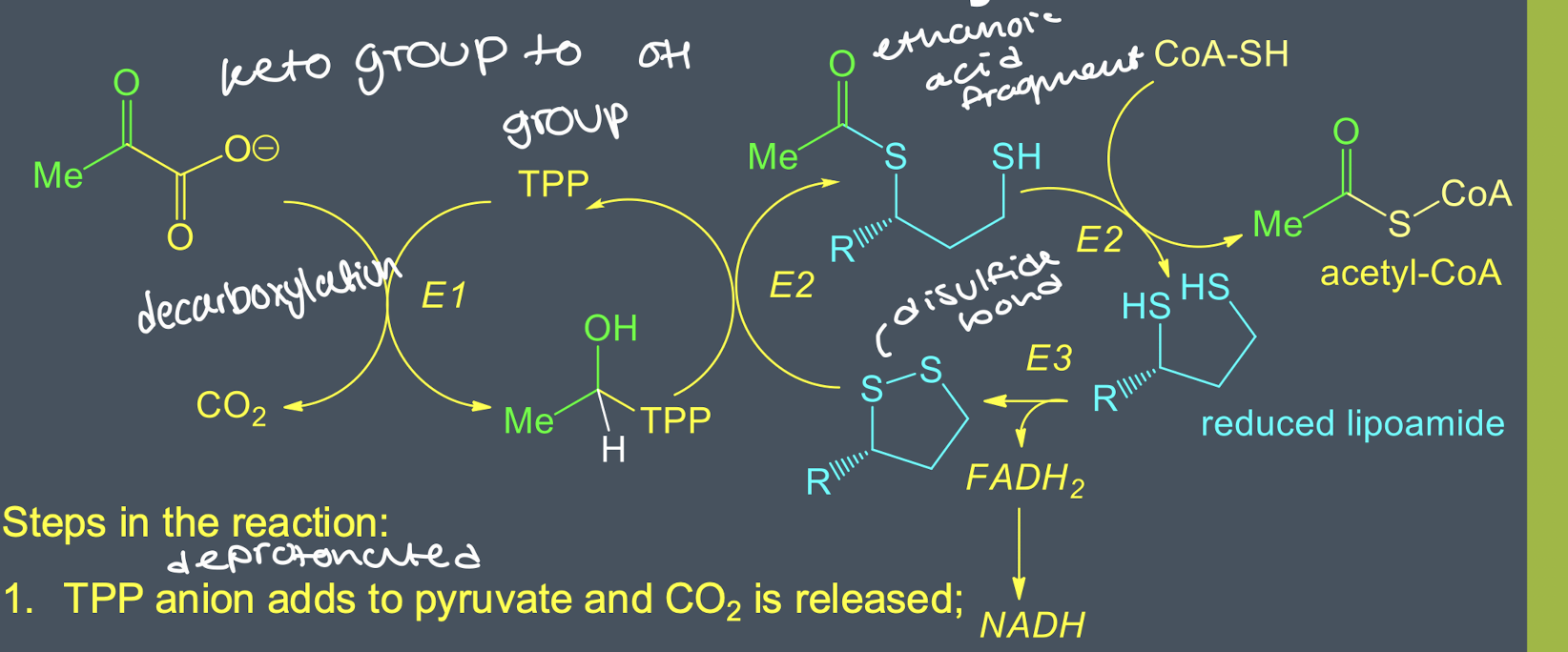
what are the features of the tricarboxylic acid cycle?
the cycle is used in both catabolic and anabolic reactions
consists of 8 steps
4 stages
acetyl-CoA is oxidised to 2 CO2 and 3 NADH and H+, 1 FADH2 and 1 GTP
O2 must be present to allow reoxidation of reduced cofactors by electron transport system
what are the 4 stages of the TCA cycle?
condensation and rearrangement(1 and 2)
decarboxylation(3 and 4)
formation of GTP(5)
conversion of succinate to oxaloacetate(6-8)
what is stage 1 of the TCA cycle?(2 steps)
citrate synthase catalyses a condensation of acetyl-CoA and oxaloacetate
hydrolysis of CoA ester makes the reaction irreversible
citrate undergoes a rearrangement to form isocitrate, this prepares for stage 2

what is stage 2 of the TCA cycle?(2 steps)
isocitrate is converted to a beta-ketoacid using NAD+(oxidation)
beta-ketoacid spontaneously loses CO2(unstable)
2-oxoglutarate is converted to succinyl-CoA by a multi-enzyme complex
reaction is analogous to that carried out by pyruvate dehydrogenase. the same cosubstrates are required(TPP, lipoamide, CoA-SH)
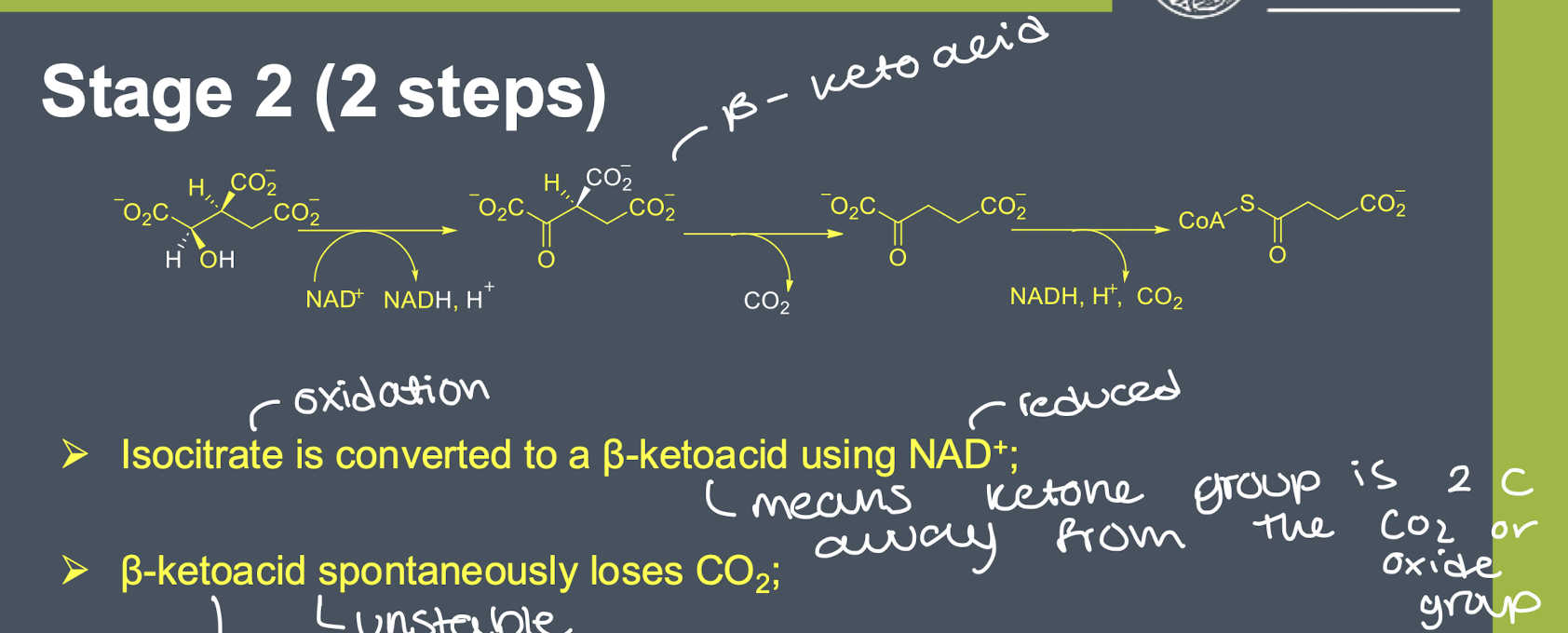
what is stage 3 of the TCA cycle?(1 step)
CoA is displaced by inorganic phosphate to produce a mixed acid anhydride
phosphate is transferred to an active site his
transfer of phosphate group onto GDP forms GTP( which can be used to synthesise ATP)

what is stage 4 of the TCA cycle?( 3 steps)
converts succinate into oxaloacetate in 3 steps
desaturattion of C-C bond using FAD(add double bond)
hydration of double bond, antiaddition of H2O to obtain S-malate
NAD+-dependent oxidation to reform oxaloacetate
the last step is driven by removal of oxaloacetate (thermodynamically unstable)(rate of reaction of TCA cycle is determined by rate of oxaloacetate formed)
produces reduced cosubstrates(which can be used in the electron transport system to make ATP)